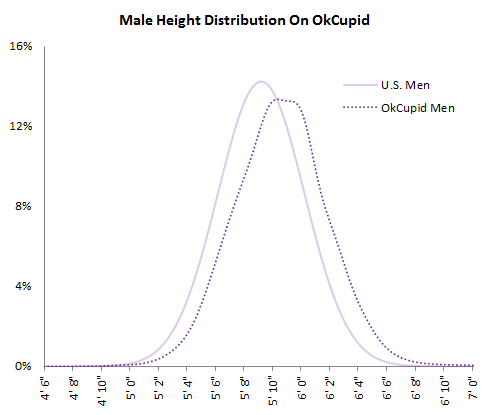David Ogilvy famously said, “The trouble with market research is that people don’t think how they feel, they don’t say what they think and they don’t do what they say.” This skepticism towards claimed data is shared by most social psychologists.
The difference between claims and the truth is starkly revealed on dating sites. Look at the graph below from OK Cupid! which shows the distributions of heights of its users. The fact it mirrors the US population, but shifted two inches to the right, suggests that people stretch the truth.

More categorical proof that consumers sometimes lie comes from The National Survey of Sexual Attitudes and Lifestyle (NATSAL), conducted by UCL and the London School of Hygiene and Tropical Medicine. In 2010 the 15,000 strong survey found that British heterosexual women admit to a mean of eight sexual partners, compared to twelve for men. The difference is logically impossible.
All of this goes to show that advertisers trying to understand their customers have a problem: if they listen uncritically to consumers, they’ll be misled.
Contending With Confabulation
It’s not just lying that makes claimed data problematic. Sometimes consumers try to be honest but they simply don’t know their motivations.
This can be seen in multiple studies – such as this one run by Adrian North, a psychologist at the University of Leicester. He ran an experiment in the wine aisle of a supermarket that found that background music was the main determinant of the nationality of wine bought by customers. However, when questioned, hardly anyone attributed their behavior to such an incidental detail.
In this experiment consumers tried to answer honestly, but they didn’t have full introspective insight into their motivations. As the New York University psychologist Jonathan Haidt says, the conscious brain thinks it is the oval office but in reality it is the press office.
The situation is particularly misleading as consumers don’t just pluck claims at random, instead they tend to present an overly logical post-rationalization of events. Rory Sutherland elaborates here.
So if listening to consumers can be misleading what should you do?
First, don’t take responses at face value. Even though the NATSAL respondents are lying their answers are illuminating. They reveal gender expectations about sex: men tend to exaggerate their promiscuity, while women downplay it. The changing ratio between men and women tells a tale too. In 1990 men claimed to have two and a half times more sexual partners than women, by 2010 the gap had dropped to 50%. Gender expectations are leveling out.
Data are not transparent. They need to be teased, analyzed and probed. Interpreting them naively will mislead you. But if you dig further, then insights can be uncovered.
Second, adapt your surveys so that you don’t always ask consumers directly. Instead have a cell approach, in which you randomly allocate participants into a cell. Each cell should ask the question in a slightly different way. By comparing the results you can isolate which incidental details are important.
Here’s a simple survey I ran with the brilliant researcher Jenny Riddell that used a cell approach to understand how our sense of value depends on the time-scale over which it is communicated.
Third, don’t just rely on surveys. Create simple field experiments that test the discrepancy between fact and claim as the basis of your experiment. Here’s an experiment I ran with the excellent Claire Linford that did just that.
This test revealed that consumers’ memories of the prices they paid for items are shaped by the means of payment. This gives brands a strong reason to roll out contactless technology.
Interestingly, if you ever want to question people on the street the best thing is to offer them a $1 scratch card in return. Far more effective than offering them a dollar bill.
Fourth, look to sources other than claimed data. Search data is one such place. Have a look at this site.
All you do is drop a term into the search bar and it will return the most popular search strings that have that term and a question word (e.g. who, what, how, why). By including a question word it strips all the noise out and instead you get a great sense of what people really think about your category.
So to finish, two book recommendations.
First Dataclysm – by the founder of OK Cupid – one of the best books on how using observed data can give you an understanding of consumers.
And second, perhaps the best book on the topic of lies is Born Liars by Ian Leslie.
You can find more ideas like this in my new book The Choice Factory: 25 Behavioral Biases That Influence What We Buy (Recently named the #1 book ever written on Advertising by BBH)
The Blake Project Can Help: Ask us about measuring the equity of your brand
Branding Strategy Insider is a service of The Blake Project: A strategic brand consultancy specializing in Brand Research, Brand Strategy, Brand Licensing and Brand Education




